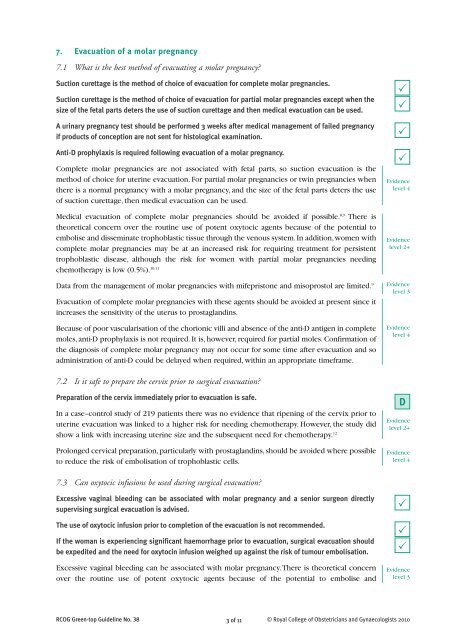The Management of Gestational Trophoblastic Disease - Green-top 38
The Management of Gestational Trophoblastic Disease - Green-top 38
The Management of Gestational Trophoblastic Disease - Green-top 38
You also want an ePaper? Increase the reach of your titles
YUMPU automatically turns print PDFs into web optimized ePapers that Google loves.
7. Evacuation <strong>of</strong> a molar pregnancy<br />
7.1 What is the best method <strong>of</strong> evacuating a molar pregnancy?<br />
Suction curettage is the method <strong>of</strong> choice <strong>of</strong> evacuation for complete molar pregnancies.<br />
Suction curettage is the method <strong>of</strong> choice <strong>of</strong> evacuation for partial molar pregnancies except when the<br />
size <strong>of</strong> the fetal parts deters the use <strong>of</strong> suction curettage and then medical evacuation can be used.<br />
A urinary pregnancy test should be performed 3 weeks after medical management <strong>of</strong> failed pregnancy<br />
if products <strong>of</strong> conception are not sent for histological examination.<br />
Anti-D prophylaxis is required following evacuation <strong>of</strong> a molar pregnancy.<br />
Complete molar pregnancies are not associated with fetal parts, so suction evacuation is the<br />
method <strong>of</strong> choice for uterine evacuation. For partial molar pregnancies or twin pregnancies when<br />
there is a normal pregnancy with a molar pregnancy, and the size <strong>of</strong> the fetal parts deters the use<br />
<strong>of</strong> suction curettage, then medical evacuation can be used.<br />
Medical evacuation <strong>of</strong> complete molar pregnancies should be avoided if possible. 8,9 <strong>The</strong>re is<br />
theoretical concern over the routine use <strong>of</strong> potent oxytocic agents because <strong>of</strong> the potential to<br />
embolise and disseminate trophoblastic tissue through the venous system. In addition, women with<br />
complete molar pregnancies may be at an increased risk for requiring treatment for persistent<br />
trophoblastic disease, although the risk for women with partial molar pregnancies needing<br />
chemotherapy is low (0.5%). 10,11<br />
Data from the management <strong>of</strong> molar pregnancies with mifepristone and misoprostol are limited. 9<br />
Evacuation <strong>of</strong> complete molar pregnancies with these agents should be avoided at present since it<br />
increases the sensitivity <strong>of</strong> the uterus to prostaglandins.<br />
Because <strong>of</strong> poor vascularisation <strong>of</strong> the chorionic villi and absence <strong>of</strong> the anti-D antigen in complete<br />
moles, anti-D prophylaxis is not required. It is, however, required for partial moles. Confirmation <strong>of</strong><br />
the diagnosis <strong>of</strong> complete molar pregnancy may not occur for some time after evacuation and so<br />
administration <strong>of</strong> anti-D could be delayed when required, within an appropriate timeframe.<br />
P<br />
P<br />
P<br />
P<br />
Evidence<br />
level 4<br />
Evidence<br />
level 2+<br />
Evidence<br />
level 3<br />
Evidence<br />
level 4<br />
7.2 Is it safe to prepare the cervix prior to surgical evacuation?<br />
Preparation <strong>of</strong> the cervix immediately prior to evacuation is safe.<br />
In a case–control study <strong>of</strong> 219 patients there was no evidence that ripening <strong>of</strong> the cervix prior to<br />
uterine evacuation was linked to a higher risk for needing chemotherapy. However, the study did<br />
show a link with increasing uterine size and the subsequent need for chemotherapy. 12<br />
Prolonged cervical preparation, particularly with prostaglandins, should be avoided where possible<br />
to reduce the risk <strong>of</strong> embolisation <strong>of</strong> trophoblastic cells.<br />
D<br />
Evidence<br />
level 2+<br />
Evidence<br />
level 4<br />
7.3 Can oxytocic infusions be used during surgical evacuation?<br />
Excessive vaginal bleeding can be associated with molar pregnancy and a senior surgeon directly<br />
supervising surgical evacuation is advised.<br />
<strong>The</strong> use <strong>of</strong> oxytocic infusion prior to completion <strong>of</strong> the evacuation is not recommended.<br />
If the woman is experiencing significant haemorrhage prior to evacuation, surgical evacuation should<br />
be expedited and the need for oxytocin infusion weighed up against the risk <strong>of</strong> tumour embolisation.<br />
Excessive vaginal bleeding can be associated with molar pregnancy. <strong>The</strong>re is theoretical concern<br />
over the routine use <strong>of</strong> potent oxytocic agents because <strong>of</strong> the potential to embolise and<br />
P<br />
P<br />
P<br />
Evidence<br />
level 3<br />
RCOG <strong>Green</strong>-<strong>top</strong> Guideline No. <strong>38</strong> 3<strong>of</strong> 11 © Royal College <strong>of</strong> Obstetricians and Gynaecologists 2010
















